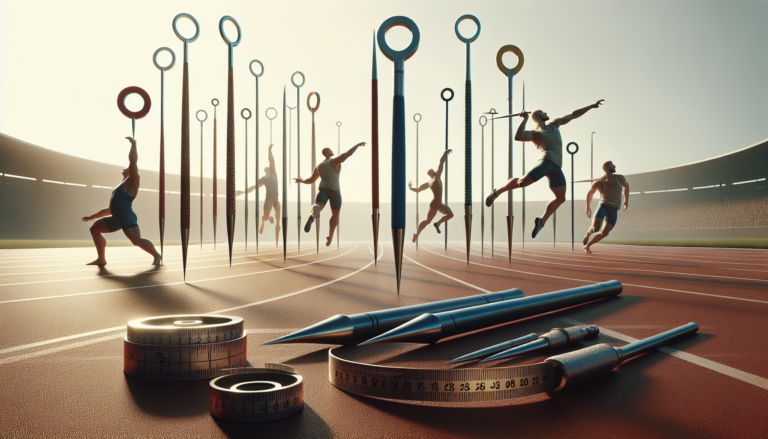The javelin throw is one of the most captivating events in track and field, showcasing the perfect blend of strength, technique, and precision. As an Olympic event, the javelin throw has a rich history and continues to be a significant part of modern athletics. In this comprehensive guide, we will explore the intricacies of javelin throw techniques, training, equipment, and notable athletes who have left their mark on this exhilarating sport.
Introduction to Javelin Throw
History of Javelin Throw
The javelin throw has its roots in ancient hunting and warfare, where spears were thrown for both survival and combat. As a modern Olympic event, the javelin throw first appeared in the 1908 London Games for men and the 1932 Los Angeles Games for women. Since then, the sport has evolved, with advancements in technique, equipment, and training methods.
Significance in Modern Athletics
Today, the javelin throw is a highly competitive event in track and field, with athletes from around the world striving to push the boundaries of human performance. The sport requires a unique combination of explosive power, speed, and technical finesse, making it a thrilling spectacle for both athletes and spectators alike. The javelin throw is featured in major international competitions, such as the Olympic Games, World Championships, and Diamond League events.
Basic Techniques of Javelin Throw
Grip and Hold
Mastering the proper grip and hold is essential for a successful javelin throw. The most common grip is the Finnish grip, where the javelin is held with the palm facing up and the thumb and index finger forming a V-shape around the cord. The grip should be relaxed yet firm, allowing for a smooth release. Experimenting with different grip positions can help athletes find the most comfortable and effective hold for their throwing style.
Approach and Run-Up
The approach and run-up are crucial components of the javelin throw, as they generate the necessary speed and power for a long and accurate throw. A typical run-up consists of a 10-12 step approach, with a gradual acceleration leading to a explosive final few steps. Athletes must maintain a straight path and a tall posture, focusing on a smooth and rhythmic movement. The penultimate step, known as the “cross-over step,” is critical for setting up the throwing position and transferring energy from the run-up to the throw.
Release and Follow-Through
The release and follow-through are the final stages of the javelin throw, where athletes aim to transfer all their generated energy into the javelin. The release should occur at an optimal angle of 30-36 degrees, with the javelin leaving the hand at the highest point possible. Athletes must maintain a strong and stable throwing arm, with the elbow leading the movement. The follow-through is essential for preventing injuries and ensuring a complete transfer of energy. After the release, athletes should continue the throwing motion, allowing their body to decelerate naturally.
Advanced Techniques for Precision and Power
Optimizing Angle of Release
One of the most critical factors in achieving maximum distance and accuracy in the javelin throw is the angle of release. Studies have shown that the optimal release angle is between 30 and 36 degrees, depending on the athlete’s height, arm length, and throwing velocity. To optimize the angle of release, athletes can use video analysis and work with coaches to fine-tune their technique. Drills focusing on the release point and follow-through can help athletes develop a consistent and efficient release.
Strength and Conditioning
Strength and conditioning play a vital role in improving javelin throw performance. Athletes should focus on exercises that target the shoulders, chest, back, and core muscles, as these are the primary muscle groups involved in the throwing motion. Plyometric exercises, such as medicine ball throws and bounding, can help develop explosive power. Resistance training, using weights or resistance bands, can improve overall strength and muscle endurance. A well-rounded strength and conditioning program should also include flexibility and mobility work to prevent injuries and maintain optimal range of motion.
Mental Preparation
Mental preparation is often overlooked but is equally important as physical training for javelin throwers. Athletes must develop a strong mental game to cope with the pressures of competition and maintain focus during training. Visualization techniques, such as mentally rehearsing the perfect throw, can help athletes build confidence and prepare for various scenarios. Relaxation methods, like deep breathing and progressive muscle relaxation, can help manage stress and anxiety. Setting clear goals, both short-term and long-term, can provide motivation and direction for athletes throughout their training and competitions.
Training and Drills for Javelin Throw
Warm-Up Exercises
A proper warm-up is essential for preventing injuries and preparing the body for the demands of javelin throwing. A typical warm-up should include:
- Light jogging or skipping to increase heart rate and blood flow
- Dynamic stretches targeting the shoulders, chest, back, and legs
- Mobility exercises for the ankles, hips, and thoracic spine
- Activation drills for the core and throwing arm muscles
Technique Drills
Technique drills are designed to isolate and improve specific aspects of the javelin throw. Some common drills include:
| Drill | Purpose |
|---|---|
| Standing throws | Develops proper release and follow-through |
| Crow-hop throws | Emphasizes weight transfer and rhythm |
| Step and throw | Focuses on the cross-over step and throwing position |
| Pull throws | Strengthens the throwing arm and shoulder muscles |
Strength Training
Strength training is crucial for developing the necessary power and muscle endurance for javelin throwing. A well-rounded strength training program should include:
- Compound exercises: squats, deadlifts, bench press, and pull-ups
- Shoulder-specific exercises: overhead press, lateral raises, and rotator cuff work
- Core stability exercises: planks, russian twists, and medicine ball throws
- Plyometric exercises: box jumps, bounding, and medicine ball slams
Equipment and Gear for Javelin Throw
Choosing the Right Javelin
Selecting the appropriate javelin is essential for optimal performance and safety. Javelins come in different weights and lengths, depending on the age and gender of the athlete. The most common javelin weights are:
- 600g for men
- 500g for women
- 700g and 800g for youth athletes
Athletes should choose a javelin that fits their throwing style, skill level, and physical characteristics. Consulting with a coach or experienced thrower can help in making the right choice.
Essential Gear and Accessories
In addition to the javelin, there are several essential pieces of gear and accessories that javelin throwers should consider:
- Throwing shoes: Provide stability and traction during the run-up and release
- Gloves: Help maintain a secure grip on the javelin and prevent blisters
- Arm sleeves: Offer compression and support for the throwing arm
- Chalk or rosin: Applied to the hands to improve grip and absorb sweat
Rules and Regulations of Javelin Throw
Competition Rules
Javelin throw competitions are governed by a set of rules to ensure fairness and safety. Some key rules include:
- Athletes must throw the javelin within the designated runway and sector
- The javelin must land tip-first for a valid throw
- Athletes have a limited time to complete their attempt after being called
- Fouls, such as stepping over the foul line or throwing outside the sector, result in a no-mark
Scoring and Measurement
In javelin throw competitions, the distance of each throw is measured from the foul line to the point where the tip of the javelin first struck the ground. The measurement is taken using a certified steel tape or an electronic distance measuring device. Athletes typically have three attempts in the preliminary round, with the top performers advancing to the final round for an additional three attempts. The athlete with the longest legal throw is declared the winner.
Notable Javelin Throwers and Records
Arshad Nadeem’s Record-Breaking Throw
Arshad Nadeem, a Pakistani javelin thrower, made history at the Paris 2024 Olympics by setting a new Olympic record with a throw of 92.97 meters. This remarkable achievement not only earned him the gold medal but also marked Pakistan’s first individual gold medal at the Olympics and its first Olympic medal in over three decades. Nadeem’s success story is one of perseverance and dedication, as he achieved this feat without any government support, relying solely on his own hard work and determination.
Neeraj Chopra’s Achievements
Neeraj Chopra, an Indian javelin thrower, has made significant strides in the sport, becoming the first Indian to win an Olympic gold medal in track and field at the Tokyo 2020 Olympics. Chopra’s journey to the top has been marked by consistent performance and steady improvement. At the Paris 2024 Olympics, Chopra showcased his skills once again, securing the silver medal with a best throw of 89.45 meters, despite facing challenges with multiple fouls during the competition.
Other Legendary Javelin Throwers
Throughout history, several javelin throwers have left an indelible mark on the sport with their outstanding performances and records. Some of these legendary athletes include:
- Jan Železný (Czech Republic): Three-time Olympic gold medalist and world record holder
- Andreas Thorkildsen (Norway): Two-time Olympic gold medalist and multiple World Champion
- Thomas Röhler (Germany): Olympic gold medalist and European record holder
- Barbora Špotáková (Czech Republic): Two-time Olympic gold medalist and world record holder in women’s javelin throw
Conclusion and Future of Javelin Throw
The Evolution of Techniques
As the sport of javelin throw continues to evolve, so do the techniques and training methods employed by athletes and coaches. Advancements in sports science, biomechanics, and technology have allowed for a deeper understanding of the factors that contribute to successful javelin throwing. Athletes are now able to analyze their technique in greater detail, using high-speed cameras, motion capture systems, and other sophisticated tools. This has led to the development of more efficient and effective training programs, focusing on optimizing every aspect of the throw.
Upcoming Competitions and Prospects
The future of javelin throw looks bright, with a new generation of talented athletes emerging and pushing the boundaries of the sport. Upcoming major competitions, such as the 2028 Los Angeles Olympics and the 2032 Brisbane Olympics, promise to showcase the best javelin throwers from around the world. As the sport continues to gain popularity and attract more participants, we can expect to see even more remarkable performances and records in the years to come.
The javelin throw is a captivating and technically demanding sport that requires a combination of strength, precision, and mental fortitude. By understanding the basic and advanced techniques, implementing effective training programs, and learning from the successes of notable athletes, aspiring javelin throwers can work towards mastering the art of precision and power. As the sport continues to evolve, the javelin throw will undoubtedly remain a thrilling and awe-inspiring event in the world of athletics.





